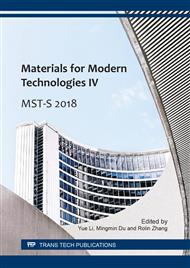[1]
P.A. Kobielska, A.J. Howarth, O.K. Farha, S. Nayak, Metal–organic frameworks for heavy metal removal from water, Coordination Chemistry Reviews. 358 (2018) 92-107.
DOI: 10.1016/j.ccr.2017.12.010
Google Scholar
[2]
T. Yang, H.J. Huang, F.Y. Lai, Pollution hazards of heavy metals in sewage sludge from four wastewater treatment plants in Nanchang, China, Transactions of Nonferrous Metals Society of China (English Edition). 27 (2017) 2249-2259.
DOI: 10.1016/s1003-6326(17)60251-6
Google Scholar
[3]
A. Jafari, B. Kamarehie, M. Ghaderpoori, N. Khoshnamvand, M. Birjandi, The concentration data of heavy metals in Iranian grown and imported rice and human health hazard assessment, Data in Brief. 16 (2018) 453-459.
DOI: 10.1016/j.dib.2017.11.057
Google Scholar
[4]
A. El-Tahera, H.M.H. Zakaly, R. Elsaman, Environmental implications and spatial distribution of natural radionuclides and heavy metals in sediments from four harbours in the Egyptian Red Sea coast, Applied Radiation and Isotopes. 131 (2018) 13-22.
DOI: 10.1016/j.apradiso.2017.09.024
Google Scholar
[5]
H.T. Wang, J.W. Wang, R. Liu, W.W. Yu, Z.Y. Shen, Spatial variation, environmental risk and biological hazard assessment of heavy metals in surface sediments of the Yangtze River estuary, Marine Pollution Bulletin. 93 (2015) 250-258.
DOI: 10.1016/j.marpolbul.2015.01.026
Google Scholar
[6]
Y.J. Yi, C.H. Tang, T.C. Yi, Z.F. Yang, S.H. Zhang, Health risk assessment of heavy metals in fish and accumulation patterns in food web in the upper Yangtze River, China, Ecotoxicology and Environmental Safety. 145 (2017) 295-302.
DOI: 10.1016/j.ecoenv.2017.07.022
Google Scholar
[7]
C. Femina Carolina, P. Senthil Kumar, A. Saravanana, G. Janet Joshiba, M. Naushad, Efficient techniques for the removal of toxic heavy metals from aquatic environment: A review, Journal of Environmental Chemical Engineering. 5 (2017) 2782-2799.
DOI: 10.1016/j.jece.2017.05.029
Google Scholar
[8]
Y.K. Ma, P. Egodawatta, J. McGree, A. Liu, A. Goonetilleke, Human health risk assessment of heavy metals in urban stormwater, Science of the Total Environment. 557-558 (2016) 764-772.
DOI: 10.1016/j.scitotenv.2016.03.067
Google Scholar
[9]
L.K. Wang, D.A. Vaccari, Y. Li, N.K. Shammas, Chemical Precipitation, Humana, Passaic, (2005).
Google Scholar
[10]
T. Nguyen, M. Fátima Montemor, Redox active materials for metal compound based hybrid electrochemical energy storage: a perspective view, Applied Surface Science. 422 (2017) 492-497.
DOI: 10.1016/j.apsusc.2017.06.008
Google Scholar
[11]
W. Zhang, R. Xiong, G. Wei, Biological flocculation treatment on distillery wastewater and recirculation of wastewater, Journal of Hazardous Materials. 172 (2009) 1252-1257.
DOI: 10.1016/j.jhazmat.2009.07.150
Google Scholar
[12]
P.J.M. Martins, P.M. Reis, R.C. Martins, L.M. Gando-Ferreira, R.M. Quinta-Ferreira, Iron recovery from the Fenton's treatment of winery effluent using an ion-exchange resin, Journal of Molecular Liquids. 242 (2017) 505-511.
DOI: 10.1016/j.molliq.2017.07.041
Google Scholar
[13]
J. Rajewski, P. Religa, Synergistic extraction and separation of chromium(III) from acidic solution with a double-carrier supported liquid membrane, Journal of Molecular Liquids. 218 (2016) 309-315.
DOI: 10.1016/j.molliq.2016.02.079
Google Scholar
[14]
Y. Yang, J. Fein, Adsorption of metals by geomedia III: Fundamentals and implications of metal adsorption, Chemical Geology. 464 (2017) 1-3.
DOI: 10.1016/j.chemgeo.2017.04.013
Google Scholar
[15]
L. Zhu, R. Zhang, Z. Zhu, Progress of metal-ion imprinting technology, Chemistry. 73 (2010) 326-331.
Google Scholar
[16]
R. Zhang, B. Wang, H. Ma, Studies on Cr(VI) adsorption on sulfonated lignite, Desalination. 255 (2010) 61-66.
DOI: 10.1016/j.desal.2010.01.016
Google Scholar
[17]
J.Y. Gu, R. Sun, T.G. Ge, Z.L. Zhu, Adsorption and recognition performance of lead ion-imprinted micro-beads, Journal of Tong Ji University (Natural Science). 41 (2013) 1507-1512.
Google Scholar
[18]
R. Fan, X. Zheng, Thermodynamics and dynamics for adsorption of heavy metal ions on Pb(Ⅱ) ion-imprinted composite membrane, Ciesc Journal. 64 (2012) 1651-1659.
Google Scholar
[19]
Z.C. Yuan, Y.K. Zhu, Y. Lan, D.J. Chen, Preparation of Cu(II)-imprinted smart microgels for selective separation of copper ions, Separation Science & Technology. 50 (2015) 1480-1486.
DOI: 10.1080/01496395.2014.976879
Google Scholar
[20]
Z. Ren, X. Zhu, J. Du, D. Kong, N. Wang, Q. Wang, W. Liu, Q. Li, Z. Zhou, Facile and green preparation of novel adsorption materials by combining sol-gel with ion imprinting technology for selective removal of Cu(Ⅱ) ions from aqueous solution, Applied Surface Science. 435 (2018).
DOI: 10.1016/j.apsusc.2017.11.059
Google Scholar
[21]
L. Zhang, L. Zhong, S. Yang, D. Liu, Y. Wang, S. Wang, X. Han, X. Zhang, Adsorption of Ni(II) ion on Ni(II) ion-imprinted magnetic chitosan/poly(vinyl alcohol) composite, Colloid & Polymer Science. 293 (2015) 2497-2506.
DOI: 10.1007/s00396-015-3626-4
Google Scholar
[22]
X. Wang, W. Liu, T. Xue, W. Hao, W. Yang, Magnetic and molecular imprinting chitosan spheres with selective adsorption capacity of Cd2+, Journal of He Fei University of Technology (Natural Science). 38 (2015) 837-841.
Google Scholar
[23]
Buhani, Narsito, Nuryono, E.S. Kunarti, Production of metal ion imprinted polymer from mercapto–silica through sol–gel process as selective adsorbent of cadmium, Desalination. 251 (2010) 83-89.
DOI: 10.1016/j.desal.2009.09.139
Google Scholar
[24]
F.N. Acar, E. Malkoc, The removal of chromium(VI) from aqueous solutions by Fagus orientalis L, Bioresource Technology. 94 (2004) 13-15.
DOI: 10.1016/j.biortech.2003.10.032
Google Scholar
[25]
S. Periyasamy, V. Gopalakannan, N. Viswanathan, Fabrication of magnetic particles imprinted cellulose based biocomposites for chromium(Ⅵ) removal, Carbohydrate polymers. 174 (2017) 352-359.
DOI: 10.1016/j.carbpol.2017.06.029
Google Scholar


